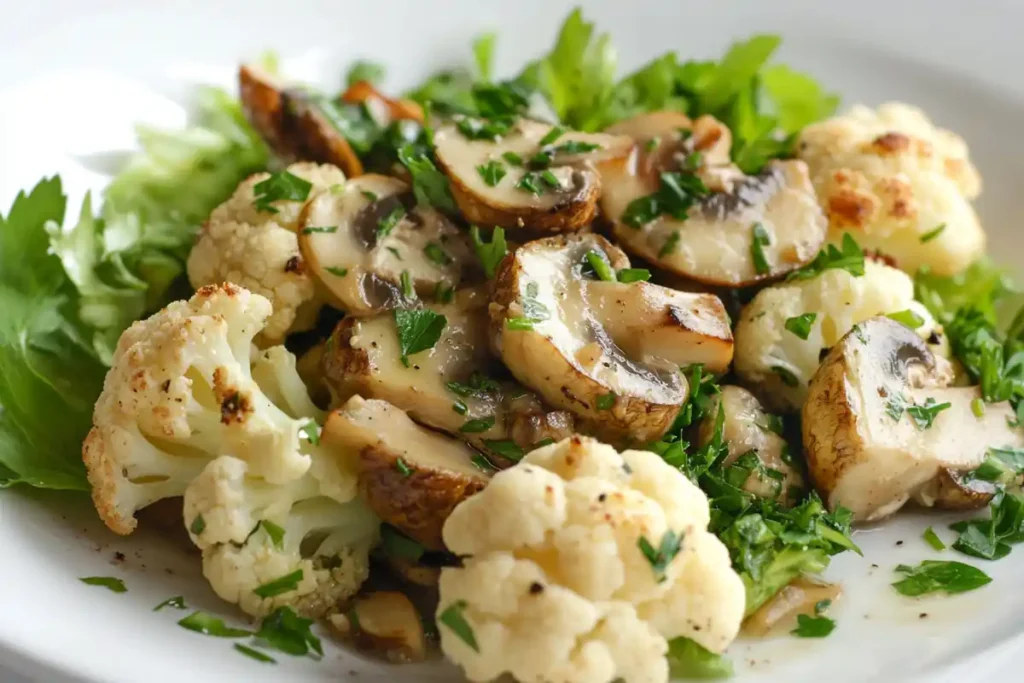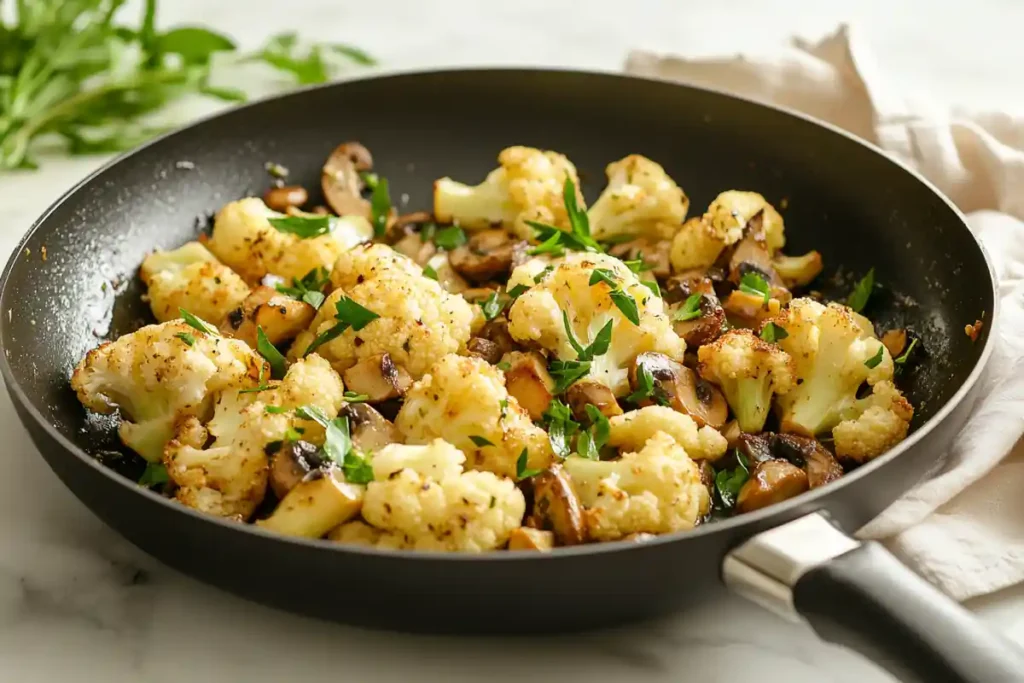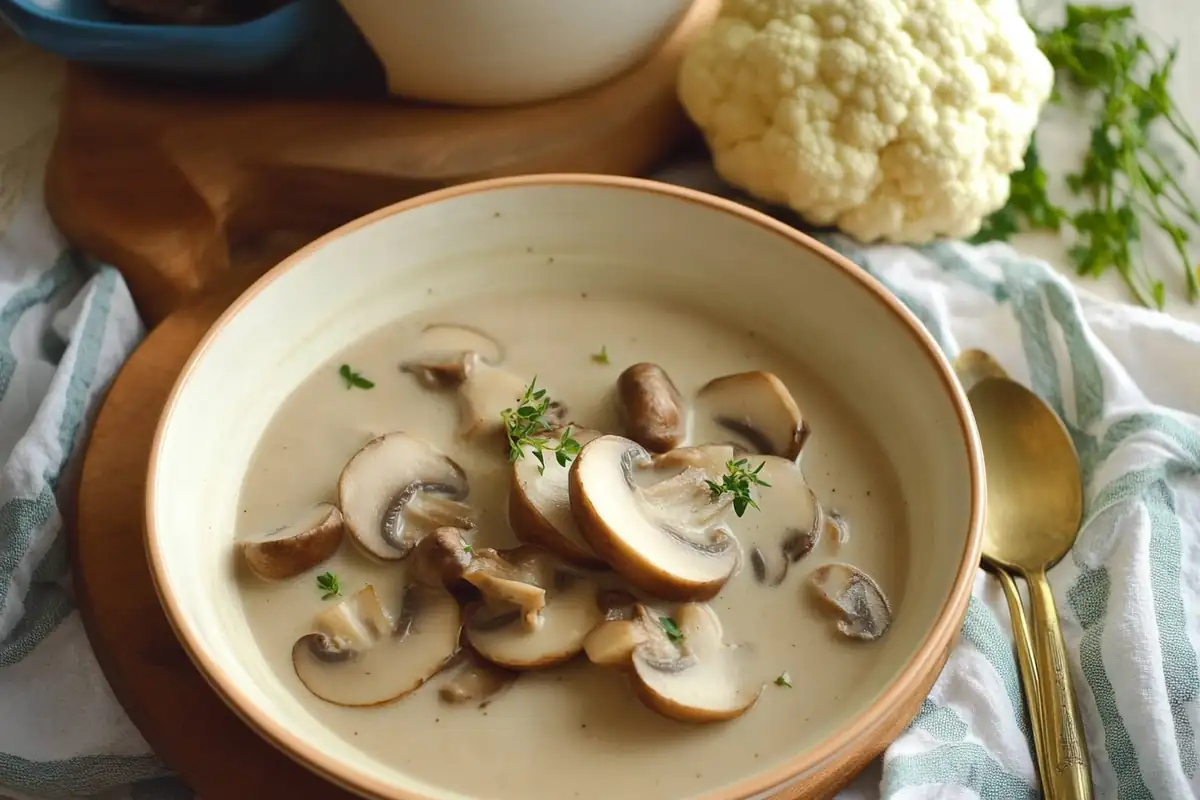introduction:
When you think about eating cauliflower mushrooms, you might wonder if they’re safe. The key is knowing how to tell them apart from poisonous mushrooms. They taste mild and nutty and are good for you, but you must identify them correctly.
Cauliflower mushrooms are safe to eat and are good for you. They have protein and lots of fiber. But, it’s important to know how to tell them apart from other mushrooms. This is because some mushrooms look very similar and can be dangerous if mistaken.
To make sure cauliflower mushrooms are safe, learn more about them before eating them. This is because some people might be allergic. Knowing where and how cauliflower mushrooms grow can help you decide if they’re safe to eat.
Key Takeaways
- Cauliflower mushrooms are edible and offer various health benefits
- Proper identification is key to avoid poisonous lookalikes
- Cauliflower mushroom safety relies on correct identification and handling
- Understanding their characteristics and habitat is essential
- Seek more information and advice before eating unknown mushrooms
- Is cauliflower mushroom safe? It depends on your knowledge and caution
- Cauliflower mushroom safety and health benefits make it a valuable food
What is Cauliflower Mushroom?
Cauliflower mushrooms, also known as Sparassis crispa, are unique. They look like a brain, with a convoluted cap and a mild, nutty taste. They grow in coniferous forests, often from the base of trees or stumps.
These mushrooms need a cool, moist place to grow. They thrive in autumn and winter, found in North America, Europe, and Asia. They are known for their off-white spore print and high levels of nutrients like β-glucan, potassium, phosphorus, and sodium.
- They have a unique, brain-like appearance
- They have a mild, nutty flavor
- They are found in coniferous forests, typically growing from the base of living or dead trees, or on conifer stumps
- They require a cool and moist environment to grow
| Latin Name | Common Names | Season | Habitat |
|---|---|---|---|
| Sparassis Crispa | Wood Cauliflower, Cauliflower Fungus, Brain Fungus | Autumn & Winter | Grows from the base of living or dead conifers, or on conifer stumps |
Nutritional Benefits of Cauliflower Mushroom
Cauliflower mushrooms are packed with nutrients, making them a healthy choice. They are full of vitamins and minerals. They also have antioxidants and a lot of dietary fiber. These help keep you healthy and can fight off chronic diseases, as seen in healthy recipe ideas.
Vitamins and Minerals
Cauliflower mushrooms are rich in important vitamins and minerals. They have B vitamins like niacin, pantothenic acid, and folate. They also have minerals like potassium. These are key for energy, nerve health, and a strong heart.
Antioxidant Properties
The antioxidants in cauliflower mushrooms protect your body from harm. Free radicals can damage cells and cause diseases like cancer and heart disease. Eating foods with antioxidants, like cauliflower mushrooms, boosts your health.
Dietary Fiber Content
Cauliflower mushrooms are also high in dietary fiber. This is good for your digestive health. Eating enough fiber can lower cholesterol, control blood sugar, and help with regular bowel movements.
To add cauliflower mushrooms to your meals, try them in soups, stews, or as a side dish. You can also use them in pasta dishes or as a meat substitute in vegetarian recipes.
| Nutrient | Amount per 100g |
|---|---|
| Vitamin B1 | 0.1 mg |
| Vitamin B2 | 0.2 mg |
| Potassium | 450 mg |
| Dietary Fiber | 2.5 g |
Common Varieties of Cauliflower Mushroom

Exploring cauliflower mushrooms means knowing the different types. It’s important to know which ones are safe to eat. With over 14,000 mushroom species, it might seem hard. But, focusing on common ones makes it easier.
The cauliflower mushroom is a favorite for its unique look and taste.
Edible Varieties
Some tasty edible mushrooms are the chanterelle and the cremini. They have a fruity and peppery taste. These mushrooms are not only tasty but also full of nutrients.
Identifying Safe Varieties
To find safe mushrooms, you need to know their features. For example, the cauliflower mushroom looks like a brain and is white or light brown. Talking to mushroom experts or using guides can help too.
How to Properly Harvest Cauliflower Mushroom
Harvesting cauliflower mushrooms right is key to keeping nature healthy. It’s important to cut them at the base of the stem. This lets the mushroom grow back. It’s better than pulling them out.
When you harvest, think about the mushroom’s home. Don’t take too many. Leave some to grow again. Also, watch out for worms in mushrooms like porcini and pine.
Respecting nature is part of foraging. Avoid chemicals and harm to wildlife. This way, you help the environment and ensure mushrooms keep growing.
Here are some tips for harvesting cauliflower mushrooms:
- Learn about the mushroom you’re picking to know its needs
- Harvest carefully to protect the environment
- Follow local rules for mushroom picking
Cooking Methods for Cauliflower Mushroom

There are many ways to cook cauliflower mushroom to bring out its flavor and texture. One favorite method is sautéing it in butter or oil. Add salt, pepper, and herbs for extra taste. This method gives a crispy outside and a soft inside, perfect for many dishes.
For a vegan option, swap butter for olive oil and use vegetable stock or water. Adding garlic, thyme, or lemon zest can make it even tastier. You can also mix different mushrooms like shiitake or cremini for more flavor.
Here are some tips for cooking cauliflower mushroom:
- Use a mix of mushrooms and cauliflower for a rich taste
- Add garlic and shallots for extra flavor
- Cook in batches to avoid overcrowding the pan
- Season with salt, pepper, and herbs to taste
Try adding soy toasted pumpkin seeds or truffle oil for extra flair. The cooking methods for cauliflower mushroom offer a lot of flexibility. You can play with different ingredients and seasonings to find your favorite. With these popular recipes and flavor pairing suggestions, you can make a dish that’s both delicious and memorable.
| Ingredient | Quantity |
|---|---|
| Mushrooms | 1 pound (500g) |
| Cauliflower | 1 head (2 pounds/925g) |
| Butter or oil | 2 tablespoons (30g) |
Potential Risks of Consuming Cauliflower Mushroom
Foraging for cauliflower mushrooms comes with risks. One big concern is toxic look-alikes that can be mistaken for safe mushrooms. These can lead to serious health problems, including allergic reactions, if eaten.
Some people might also have allergic reactions to cauliflower mushrooms. These can range from mild symptoms like itching and swelling to severe anaphylaxis. It’s important to know these risks and take precautions when eating cauliflower mushrooms.
Toxic Look-Alikes
Toxic look-alikes live in the same places as cauliflower mushrooms, making them hard to tell apart. Some dangerous look-alikes include certain Amanita and Gyromitra species. Always be careful when picking mushrooms and check with an expert or a trusted field guide to make sure you have the right one.
Allergic Reactions
Allergic reactions to cauliflower mushrooms can happen due to compounds like histamine and tyramine. These can cause symptoms like hives, itching, and trouble breathing. If you have these symptoms after eating cauliflower mushrooms, get medical help right away.
How to Identify Safe Cauliflower Mushroom
To find a safe cauliflower mushroom, start by looking at its appearance. It should have a brain-like or cauliflower-like shape, often white or cream-colored. The cap can grow up to 8 inches wide and has a unique, wavy texture.
Also, check the mushroom’s texture and smell. The flesh is firm and white, with a sweet, earthy scent. Pay attention to how it feels and smells, as these can tell you if it’s safe to eat.
Here are some important things to look for when identifying a cauliflower mushroom:
- A unique, brain-like or cauliflower-like appearance
- A white or cream-colored cap with a wavy texture
- A firm, white flesh with a sweet, earthy aroma
By looking at these features, you can feel more sure about finding a safe cauliflower mushroom.
Where to Buy Cauliflower Mushroom
Looking for cauliflower mushroom? You can find it in different places, depending on where you live and the season. Check out local farmers’ markets or specialty grocery stores for exotic produce.
These places usually have the freshest and best mushrooms. You might find them cheaper than in big supermarkets. Plus, buying local supports the economy and sustainable farming.
Farmers’ Markets
Farmers’ markets are great for finding cauliflower mushroom. Many vendors sell rare and exotic produce. You can ask about the mushrooms’ origin and quality, and get cooking tips.
Specialty Grocery Stores
Specialty stores with gourmet or international items often have cauliflower mushroom. They might have more mushroom types, and the staff can help you choose.
Some top places to buy cauliflower mushroom include:
- Whole Foods Market
- Trader Joe’s
- Asian markets
- Local health food stores
When buying cauliflower mushroom, check its freshness and quality. Look for mushrooms that are firm, creamy-white to pale-yellow, and have a fresh, earthy smell. Stay away from slimy, moldy, or smelly mushrooms.
Shopping at farmers’ markets or specialty stores means you get high-quality mushrooms. You also support local farmers and businesses. Cauliflower mushroom is a tasty and healthy addition to any meal.
| Store | Location | Availability |
|---|---|---|
| Whole Foods Market | Nationwide | Seasonal |
| Trader Joe’s | California, Arizona, Nevada | Year-round |
| Asian markets | Major cities | Year-round |
Health Considerations for Specific Populations
When consuming cauliflower mushrooms, it is important to consider specific health factors, particularly for certain groups of individuals. For example, pregnant women should exercise caution, as some mushrooms might potentially pose risks to the developing fetus. Therefore, consulting a healthcare provider before trying new foods, including cauliflower mushrooms, is strongly recommended during pregnancy.
Similarly, individuals with allergies must remain vigilant when adding cauliflower mushrooms to their diet. For instance, mushroom allergies can sometimes cause unexpected reactions, ranging from mild irritation to severe symptoms. Consequently, it is wise to monitor for any adverse effects and seek medical advice if symptoms occur.
While eating a variety of vegetables is generally beneficial for overall health, specific populations must take extra care when trying cauliflower mushrooms. For instance, pregnant women should prioritize professional guidance before introducing unfamiliar ingredients. Additionally, people with known allergies should carefully evaluate their compatibility with mushrooms to avoid potential health risks.
Moreover, being mindful of these considerations ensures a safer and more enjoyable experience with cauliflower mushrooms. On the one hand, they can be a nutritious addition to a balanced diet. On the other hand, understanding how they might impact vulnerable groups—like pregnant women and allergy sufferers—is crucial for making informed dietary decisions.
In summary, paying attention to these health considerations helps individuals make safer choices when consuming cauliflower mushrooms. As a result, both the benefits and risks are better managed, leading to a more enjoyable and health-conscious meal experience.
Conclusion: Should You Eat Cauliflower Mushroom?
Thinking about eating cauliflower mushroom? It’s key to look at the summary of benefits and risks. Cauliflower mushrooms are good for you, with less carbs and might help fight cancer. But, eating wild mushrooms can be risky, like getting sick from bad ones or eating ones with pesticides.
A summary of benefits and risks can guide you. The good stuff includes:
- Low carb content, with most varieties containing less than 3 grams of net carbs per cup serving
- Potential anti-cancer properties due to beta-glucans found in many varieties
- Promotion of normal brain function due to antioxidants like ergothioneine and selenium
But, there are downsides like pesticide exposure and getting the wrong mushroom. To stay safe, do this:
- Choose organic or sustainably sourced mushrooms when possible
- Properly identify the mushroom species to avoid misidentification
- Follow safe foraging and handling practices
In conclusion, whether to eat cauliflower mushroom depends on you. Think about the summary of benefits and risks and follow final recommendations. This way, you can choose what’s best for you.
| Mushroom Variety | Net Carbs per Cup Serving |
|---|---|
| Button Mushrooms | 1 gram |
| Portobello Mushrooms | 2 grams |
| Shiitake Mushrooms | 4 grams |
Additional Resources for Mushroom Enthuisiasts
If you love mushrooms, there’s always more to learn and explore. In fact, there are countless books, websites, and local groups to help you expand your knowledge. These resources not only keep you curious but also connect you with others who share your passion. Furthermore, they provide valuable tips to improve your foraging skills and understanding of different species.
Books and Websites
For instance, if you’re looking to dive deeper into the world of mushrooms, there are some fantastic books to consider. Mushrooms Demystified by David Arora, for example, is an excellent guide that covers many species in great detail. Similarly, The Complete Mushroom Hunter by Gary Lincoff offers useful foraging tips and detailed identification techniques. Both books are widely recommended for enthusiasts, beginners, and seasoned foragers alike.
Moreover, you can visit reputable organizations like the North American Mycological Association (NAMA) or the Mycological Society of America. These websites are packed with educational materials, vibrant forums, and detailed information about local chapters. Additionally, they host events and discussions where you can learn directly from experts in the field. By using these resources, you’ll feel more confident in identifying and handling mushrooms safely.
Local Foraging Groups
On the other hand, joining local foraging groups is a fantastic way to build your skills while enjoying a community atmosphere. These groups often host walks, workshops, and even social gatherings where you can meet like-minded individuals. For example, you can share recipes, exchange tips, and discover new foraging spots in your area. Additionally, attending these events can help you learn directly from experienced foragers who know the local terrain.
Furthermore, participating in these groups not only enhances your mushroom-hunting skills but also fosters connections with others who share your enthusiasm. Consequently, you’ll improve your knowledge and gain access to valuable insights about mushroom identification, safe handling, and cooking techniques. In short, local foraging groups are an excellent resource for anyone eager to learn more about mushrooms.
By combining these resources—books, websites, and foraging groups—you’ll have all the tools you need to explore the fascinating world of mushrooms. As a result, you’ll not only grow your expertise but also form meaningful connections with a thriving community of mushroom lovers..
FAQ
Is cauliflower mushroom safe to eat?
Eating cauliflower mushroom is safe if you know how to identify and handle it. They are nutritious but can be risky if mistaken for toxic mushrooms.
What are the health benefits of cauliflower mushroom?
Cauliflower mushrooms are full of vitamins, minerals, and antioxidants. They support your immune system and gut health when added to your diet, as highlighted in dietary fiber benefits
How can I identify safe cauliflower mushrooms?
Knowing how to identify wild mushrooms is key. Cauliflower mushrooms have unique looks, texture, and smell. Learning their features ensures you eat them safely.
What are the potentially risks of eating cauliflower mushroom?
Cauliflower mushrooms are mostly safe but can cause allergic reactions or look like toxic mushrooms. Always identify them correctly and cook them properly to avoid risks.
How should I cook cauliflower mushroom?
You can sauté, roast, or add them to soups and stews. Cooking them right brings out their flavor and texture. Always follow recipes and cook them well to avoid risks.
Where can I buy cauliflower mushrooms?
You can find cauliflower mushrooms at farmers’ markets, specialty stores, and some supermarkets. Buying locally ensures freshness and quality. Choose reputable vendors for proper guidance.
Are there any health considerations for specific populations when it comes to cauliflower mushroom?
Cauliflower mushrooms are safe for most but may pose risks for pregnant women and those with allergies. Always check with a doctor before adding them to your diet, if you have health concerns.

